
Image Credit: ACROBiosystems
Pathological symptoms of ALS
Amyotrophic lateral sclerosis (ALS) is a life-threatening neurodegenerative disorder with a two- to three-year median survival after the appearance of symptoms.
ALS mainly affects upper and lower motor neurons, but neurons in the frontal cortex and other neuroanatomical areas may also be disrupted. Muscle weakness, atrophy, spasms, and fasciculation result in the degradation of lower motor neurons from the spinal cord to the muscles. Spasms, sloppiness, impaired reflexes, and limited mobility result from the loss of upper motor neurons in the brain.
Some patients also experience extra-motor symptoms, like cognitive and behavioral issues. The most typical medical manifestation is muscle weakness and atrophy in the hands, as though the body were progressively freezing.
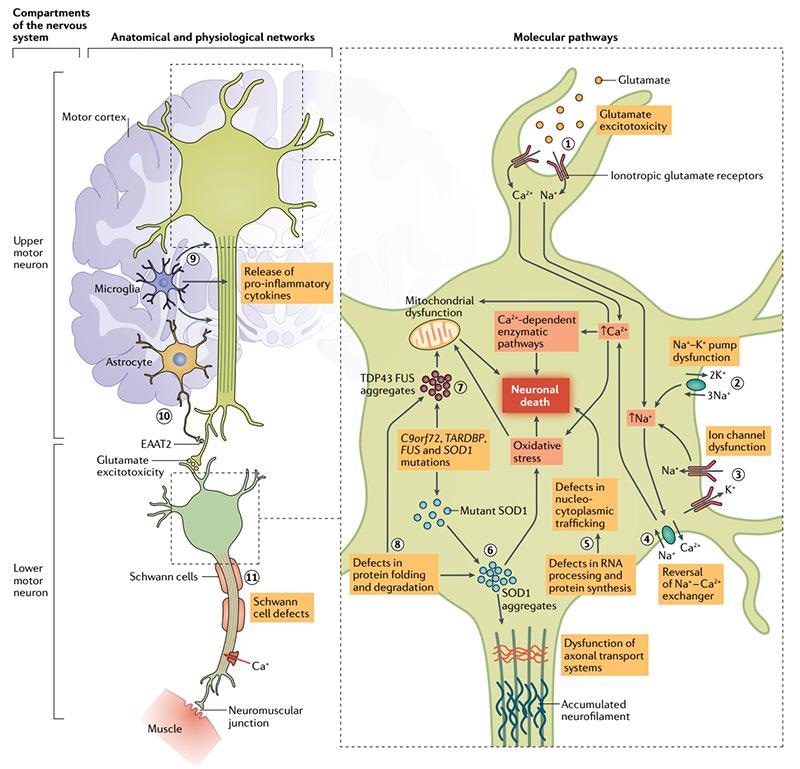
Pathophysiological mechanism of ALS. Image from reference
Epidemiology of ALS
Clinical results indicate that individuals with a history of the disease have a considerably higher incidence of the disease, and a combination of environmental and genetic aspects raises the chances of sporadic ALS.
The US National ALS Registry Act has significantly increased the overall understanding of the epidemiology of ALS, and it estimated the ALS incidence rate in the United States in 2013 to be five cases per 100,000 population. Roughly, 10% of ALS cases are familial and induced by a genetic mutation that is typically acquired in a mendelian autosomal dominant manner.
The most widely recognized genetic cause of ALS is a hexanucleotide G4C2 repeat expansion in the chromosome 9 open reading frame 72 gene (C9orf72), which accounts for 30-40% of familial ALS and provokes frontotemporal dementia (FTD).
Mutations in genes encoding copper-zinc superoxide dismutase (SOD1), transactive response DNA-binding protein 43 (TDP-43), and fused in sarcoma (FUS) contribute to more than 50% of familial ALS cases along with the C9orf72 repeat expansion, and another 30 or so genes have been recognized as potentially causing ALS.
The pathogenesis of ALS
The pathogenesis of ALS is still unknown, but pathological features and gene mutations associated with ALS have offered essential insights into the etiology of ALS. The inclusion of pathological proteins in the cells that make up the nervous system is a standard occurrence of many neurodegenerative disorders, resulting in cell impairment and even fatality.
TDP-43 ectopic aggregation in the brain is found in 97% of ALS patients (transmission from the nucleus to the cytoplasm and creation of protein aggregation), and cellular and animal studies have revealed the neurotoxicity of this pathological TDP-43. As a result, researching the mechanism of pathological TDP-43 has become an essential step toward curing ALS.
A study published in Nature Structural & Molecular Biology in 2021 proposed a feed-forward loop model involving oxidative stress. According to the findings of this study, TDP-43 nucleates gather in the cytoplasm.
On the one side, obtaining microRNA reduced the inhibitory effect of downstream target mRNAs while increasing the expression of some mitochondrial genes. Specialized mitochondrial proteins, on the other hand, were stimulated to co-agglomerate, culminating in their functional impairment. This causes an imbalance in mitochondrial structure and function, which contributes to greater ROS and improved TDP-43 truncation and aggregation.
This favorable feed cycle demonstrates that the interaction between oxidative stress and specific gene mutations may be an effective element for the onset and progression of ALS.
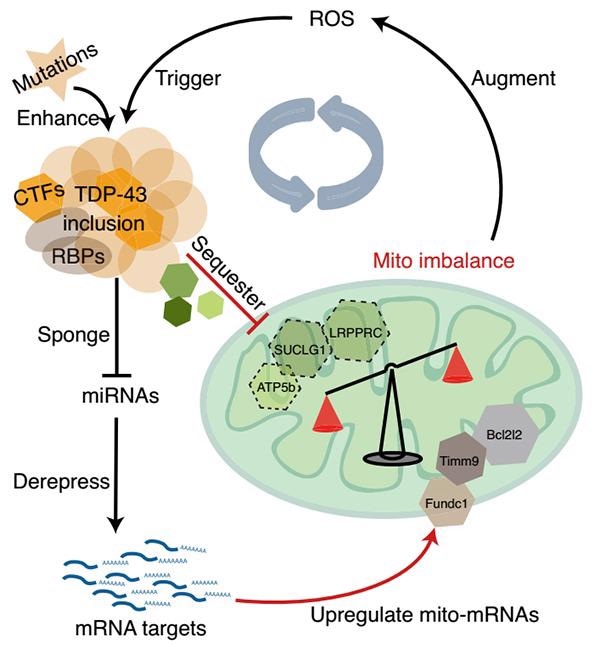
Model of feed-forward loop mitochondrial imbalance caused by TDP-43 aggregation. Image from reference
Triggering receptor expressed on myeloid cells 2, (TREM2) is only found in central nervous system microglia. TREM2 mutations are linked to Alzheimer’s disease, Parkinson’s disease (PD), and several other neurodegenerative disorders.
TREM2 mutations have also been linked to an increased risk of ALS in clinical studies. A 2021 study published in Nature Neuroscience was the first to show that microglia TREM2 plays a defensive function in TDP-43-related neurodegenerative diseases (not just ALS) and the first to identify TDP-43 as a ligand of microglia TREM2.
Depending on this, a slight improvement in microglia TREM2 expression and activity at specific disease phases may aid in the relief of ALS-related disorder. In an animal model of Alzheimer’s disease, a single dose of anti-TREM2 mAb promoted microglial metabolic activation and proliferation, boosting amyloid-beta phagocytosis (Aβ).
Therapeutic drugs for ALS
The FDA chose riluzole, a glutamate receptor antagonist, for the treatment of ALS in 1995. In 2017, the FDA approved edaravone, a powerful antioxidant and free radical scavenger initially used to cure acute ischemic stroke. As well as Ezogabine and Rasagiline, scientists are also dynamically exploring small molecule drugs, genetic pathogenesis, biological drugs, and cell therapy as potential treatments for ALS.
Aneuro focuses on neuroscience and provides SOD1 and TREM2 proteins for therapeutic drug development for ALS.
Product list
Source: ACROBiosystems
| Molecule |
Cat. No. |
Species |
Product Description |
| SOD1 |
SO1-H5148 |
Human |
Human SOD1 / Cu-Zn SOD Protein, His Tag |
| TREM2 |
TR2-H5254 |
Human |
Human TREM2 Protein, Fc Tag |
| TR2-H5256 |
Human |
Human TREM2 Protein, Mouse IgG2a Fc Tag |
| TR2-H82E7 |
Human |
Biotinylated Human TREM2 Protein, His, Avitag™ |
| TR2-H52H5 |
Human |
Human TREM2 Protein, His Tag |
| TR2-M52H3 |
Mouse |
Mouse TREM2 Protein, His Tag |
| TR2-M5254 |
Mouse |
Mouse TREM2 Protein, Fc Tag |
| TR2-C52H3 |
Cynomolgus |
Cynomolgus TREM2 Protein, His Tag |
Verification data
High purity verified by SDS-PAGE
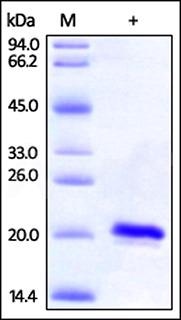
Human SOD1, His Tag (Cat. No. SO1-H5148) on SDS-PAGE under reducing (R) condition. The gel was stained overnight with Coomassie Blue. The purity of the protein is greater than 97%. Image Credit: ACROBiosystems
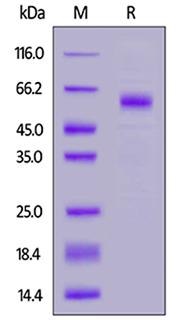
Human TREM2, Fc Tag (Cat. No. TR2-H5254) on SDS-PAGE under reducing (R) condition. The gel was stained overnight with Coomassie Blue. The purity of the protein is greater than 95%. Image Credit: ACROBiosystems
High bioactivity verified by ELISA and BLI
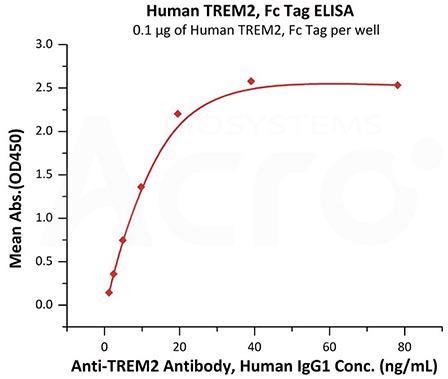
Immobilized Human TREM2, Fc Tag (Cat. No. TR2-H5254) at 1 μg/mL (100 μL/well) can bind Anti-TREM2 Antibody, Human IgG1 with a linear range of 1-20 ng/mL (QC tested). Image Credit: ACROBiosystems
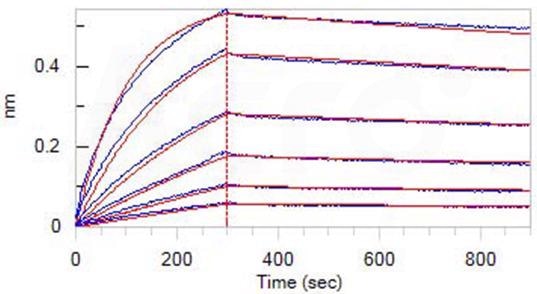
Loaded Human TREM2, Fc Tag (Cat. No. TR2-H5254) on Protein A Biosensor, can bind Human Apolipoprotein E, His Tag (Cat. No. APE-H5246) with an affinity constant of 106 nM as determined in BLI assay (ForteBio Octet Red96e). Image Credit: ACROBiosystems
References
- Kiernan MC, Vucic S, Talbot K, McDermott CJ, Hardiman O, Shefner JM, Al-Chalabi A, Huynh W, Cudkowicz M, Talman P, Van den Berg LH, Dharmadasa T, Wicks P, Reilly C, Turner MR. Improving clinical trial outcomes in amyotrophic lateral sclerosis. Nat Rev Neurol. 2021 Feb; 17(2):104-118.
- Oskarsson B, Gendron TF, Staff NP. Amyotrophic Lateral Sclerosis: An Update for 2018. Mayo Clin Proc. 2018 Nov; 93(11):1617-1628.
- Zuo X, Zhou J, Li Y, Wu K, Chen Z, Luo Z, Zhang X, Liang Y, Esteban MA, Zhou Y, Fu XD. TDP-43 aggregation induced by oxidative stress causes a global mitochondrial imbalance in ALS. Nat Struct Mol Biol. 2021 Feb; 28(2):132-142.
- Xie M, Zhao S, Bosco DB, Nguyen A, Wu LJ. Microglial TREM2 in amyotrophic lateral sclerosis. Dev Neurobiol. 2022 Jan; 82(1):125-137.
- Xie M, Liu YU, Zhao S, Zhang L, Bosco DB, Pang YP, Zhong J, Sheth U, Martens YA, Zhao N, Liu CC, Zhuang Y, Wang L, Dickson DW, Mattson MP, Bu G, Wu LJ. TREM2 interacts with TDP-43 and mediates microglial neuroprotection against TDP-43-related neurodegeneration. Nat Neurosci. 2022 Jan; 25(1):26-38.
About ACROBiosystems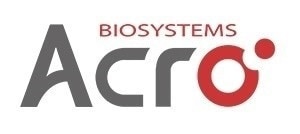
ACROBiosystems is a cornerstone enterprise of the pharmaceutical and biotechnology industries. Their mission is to help overcome challenges with innovative tools and solutions from discovery to the clinic. They supply life science tools designed to be used in discovery research and scalable to the clinical phase and beyond. By consistently adapting to new regulatory challenges and guidelines, ACROBiosystems delivers solutions, whether it comes through recombinant proteins, antibodies, assay kits, GMP-grade reagents, or custom services. ACROBiosystems empower scientists and engineers dedicated towards innovation to simplify and accelerate the development of new, better, and more affordable medicine.
Sponsored Content Policy: News-Medical.net publishes articles and related content that may be derived from sources where we have existing commercial relationships, provided such content adds value to the core editorial ethos of News-Medical.Net which is to educate and inform site visitors interested in medical research, science, medical devices and treatments.